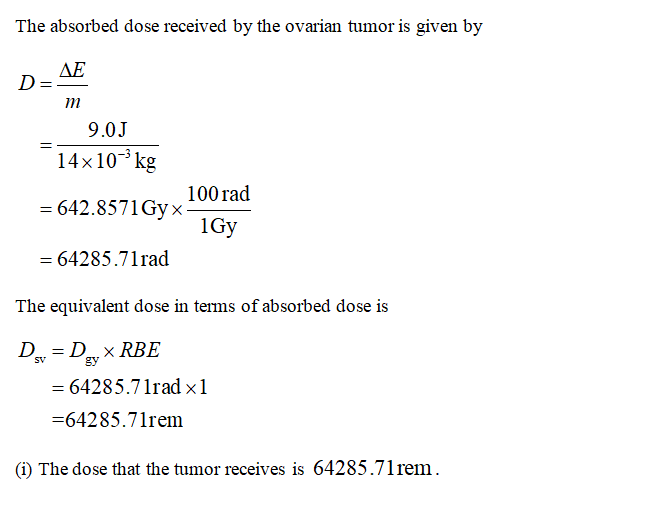A 14-gram ovarian tumor is treated using a sodium phosphate solution in which the phosphorus atoms are the radioative phosphorus-32 isotope with a half-life of 14.3 days and which decays via beta emision (RBE=1) with an energy of 1.71 MeV. Half of the sodium phosphate is absorbed by the tumor and deposits 9.0 J energy into it. The other half of the solution is absorbed throughout the patient's tissues, also depositing 9.0 J of energy into the 50.0 kg of body tissues. i. What is the dose ( in gray and rem) that the tumor receives? ii. What is the dose ( in milligray and rem) that the rest of the tissues receives?
Radioactive decay
The emission of energy to produce ionizing radiation is known as radioactive decay. Alpha, beta particles, and gamma rays are examples of ionizing radiation that could be released. Radioactive decay happens in radionuclides, which are imbalanced atoms. This periodic table's elements come in a variety of shapes and sizes. Several of these kinds are stable like nitrogen-14, hydrogen-2, and potassium-40, whereas others are not like uranium-238. In nature, one of the most stable phases of an element is usually the most prevalent. Every element, meanwhile, has an unstable state. Unstable variants are radioactive and release ionizing radiation. Certain elements, including uranium, have no stable forms and are constantly radioactive. Radionuclides are elements that release ionizing radiation.
Artificial Radioactivity
The radioactivity can be simply referred to as particle emission from nuclei due to the nuclear instability. There are different types of radiation such as alpha, beta and gamma radiation. Along with these there are different types of decay as well.
1.a. A 14-gram ovarian tumor is treated using a sodium phosphate solution in which the phosphorus atoms are the radioative phosphorus-32 isotope with a half-life of 14.3 days and which decays via beta emision (RBE=1) with an energy of 1.71 MeV. Half of the sodium phosphate is absorbed by the tumor and deposits 9.0 J energy into it. The other half of the solution is absorbed throughout the patient's tissues, also depositing 9.0 J of energy into the 50.0 kg of body tissues.
i. What is the dose ( in gray and rem) that the tumor receives?
ii. What is the dose ( in milligray and rem) that the rest of the tissues receives?
b. Photoelectrons from a material with a binding energy of 2.71 eV are ejected by 420-nm photons. Once ejected, how long does it take these electrons to travel 2.50cm to a detected device?
c.The heating element in an electric kettle is rated as 2.0kW. If the waterin the kettle is at 1000.0 oC, what volume of water will be converted in to steam in one minute? The specific latent heat of vaporization of the water is 2,257,000 j/kg and the density of water is 1,000 kg/m2.
d. Saline solution is delivered into the vein of a patient through a needle. The saline solution has a viscosity of 0.00037 Pa.s, a density of 1,060 kg/m3 , and is delivered through a 7.0-cm long needle with an internal diameter of 0.24 mm directly into the patient's vein in which the plood pressure is 130mmHg ( 1mmHg=133.4Pa). The saline solution must be delivered at a flow rate of 0.04*10-6 m3/s. How high must the saline solution be suspended in order to achieve this flow rate? Assume acceleration due to gravity is 9.81 m/s2.
e. The
i. How many Plutonium-199 nuclei are initially present in the sample?
ii. How many are present after 30.8 min?
iii. What is the activity at this time?
“Hey, since there are multiple questions posted, we will answer first question. If you want any specific question to be answered then please submit that question only or specify the question number in your message”

Step by step
Solved in 3 steps with 2 images









